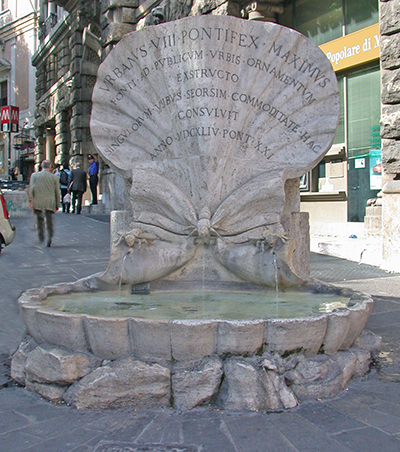The Fontana delle Api was created in 1644 by the famous artist Gian Lorenzo Bernini. The fountain that was originally located at the corner between the Piazza Barberini and Via Felice is currently known as Visa Sitina.
Since its development, this fountain has been leaning against a small palace owned by Nicolo Soderini. The fountain was used to provide drained water to horses from Triton which is the nearby fountain, and it became a sort of appendage. It was destroyed for traffic needs in 1865, and the remains were deposited in the municipal depots where they remained for several years. It was later rebuilt in 1915 by the influence of sculptor and the spokesperson of Fine Arts of the Rome Municipality at Via Veneto.
Gian Lorenzo Bernini used the Lost-wax technique to create most of his sculptures and fountains. To achieve the ornate effects in the architectural industry like the Fontana delle Api, Bernini used a technique of casting known as the Lost-wax. This was an ancient and painstaking process that resulted in the formation of the fountain.
With this technique, the first and essential step is to create a model from the wax and in this fountain; he used natural materials and objects to create the object. In some of his artistic work such as the Baldachin, he used molten bronze together with the wax to create the beautiful object.
Gian Lorenzo Bernini used several styles to build this fountain. He applied different styles to achieve the texture, naturalism, movement, and hallmarks. Concerning texture, he used to billow swirls of fabric materials to achieve the supple softness of the fountain surfaces. He paid the texture section a great deal of attention in the creation of the fountain. Viewing most of his fountains and sculptures becomes more than just a visual experience.
The fountain is tactile as well, which adds to the entire sense of the amazing realism. Naturalism is another style he utilized when creating this beautiful fountain. Just like his masters, he could create anything ranging from the gods, biblical heroes and the nymphs of Greek mythology. Most of his figures are idealized just like a perfected version of reality. He manages to decorate them with individualized features while imbuing them with human-like emotion.
From history, it is believed that Bernini helped his father in rendering the half-sunken ship making it one of the first fountains. The inspiration came just after the effects of the great flood that submerged a significant section of Rome in 1598. Once the water subsided, a destroyed or damaged ship was left sitting on the piazza.
Gentle water flows from the Fontana delle Api fountain perched below the street level, which makes most of the area’s low water pressure while supplying welcome refreshment to visitors. It consists of a large shell with various valves that are wide open. The horizontal one acted as a basin while the other supported itself at the corner of Palazzo Soderini. The three bees are a symbol of Berberini family placed on the upper section of the hinge poured water.




